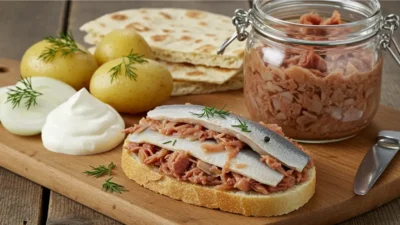Contents
Semla is a beloved Swedish winter pastry, known for its soft, lightly sweetened cardamom-flavored bun filled with almond paste and topped with whipped cream. Originally eaten only once a year on the day before Lent, this indulgent treat has since become a winter favorite across Sweden. There’s even a legendary story about King Adolf Fredrik, who ate so many semlor that he died shortly after. Semla holds a rich historical significance, and it’s enjoyed in various ways: with coffee, tea, or in hot milk. On Fettisdagen, the day before Lent, Swedes consume about 6 million semlor, highlighting just how deeply this pastry has become ingrained in Swedish culture.
Ingredients
For the buns:
- 4 cups all-purpose flour
- ½ cup sugar
- 1 tsp ground cardamom
- 1 tsp salt
- 1 packet dry yeast about 2 1/4 tsp
- 1 cup warm milk
- ⅓ cup unsalted butter, melted
- 1 egg for brushing
For the filling:
- 1½ cups almond paste
- ½ cup powdered sugar
- ½ cup heavy cream whipped
Topping:
- powdered sugar, for dusting
Instructions
- Make the dough: In a bowl, combine flour, sugar, salt, and cardamom. In a separate bowl, stir the yeast into warm milk and let it sit until foamy (about 5 minutes). Add the yeast mixture and melted butter to the dry ingredients and knead until smooth, about 8–10 minutes. Allow the dough to rise for 1 hour or until it doubles in size.

- Shape the buns: Divide the dough into 12 equal pieces and shape them into balls. Let them rise for an additional 30 minutes. Brush each bun with the beaten egg.
- Bake the buns: Preheat your oven to 400°F (200°C). Place the buns on a baking sheet and bake for 12–15 minutes, or until golden brown. Allow them to cool completely before filling.
- Prepare the filling: In a bowl, mix almond paste and powdered sugar. Gently fold in whipped cream to lighten the mixture.
- Assemble the semlor: Slice off the tops of the buns (these will act as the "hats"). Hollow out a small portion of the inside to create room for the filling. Spoon in the almond mixture, then add a generous amount of whipped cream. Place the "hat" back on top of the filled bun and dust with powdered sugar.
Notes
Semla: that sweet Swedish bun everyone craves in winter
When it’s freezing outside and the days feel like they last forever, Swedes have a cozy little secret to get through it all — semla. It's a soft, lightly sweetened bun with a hint of cardamom, stuffed with almond paste and piled high with whipped cream. A little over-the-top? Maybe. But it’s exactly what winter needs. Back in the day, semlor (yep, that’s the plural) were eaten just once a year — on the day before Lent, kind of like a final treat before the fasting began. These early versions were simple, more like a plain bun soaked in warm milk. Nothing too fancy. But oh, how times have changed.
A royal treat with humble origins
Way back in medieval Sweden, semlor were about as basic as it gets — wheat buns in warm milk, eaten as a last indulgence before Lent kicked off. Fast-forward a few hundred years, and they started to evolve. Almond paste made its way in, then whipped cream, and suddenly the bun became something really special. By the 1700s, even Swedish royalty couldn’t resist. There’s this famous (and kind of bizarre) story about King Adolf Fredrik, who reportedly loved semlor so much he ate a bunch of them during one massive meal... and then died. Was it the buns? Who knows. But it shows just how iconic this pastry became.What’s actually in a semla?
It all starts with the bun. It’s soft, a bit sweet, and spiced with cardamom — that’s the flavor that really makes it feel like winter. After baking, the top is sliced off like a little hat, and the inside gets scooped out to make room for the best part: the filling. Almond paste is mixed with powdered sugar and a bit of cream to make it smooth and rich. Then comes a big cloud of whipped cream. The hat goes back on top, and the whole thing gets a dusting of powdered sugar. Every bite is soft, creamy, sweet, and just a little messy — which is honestly part of the fun How Swedes actually eat them There’s more than one way to enjoy a semla:- With coffee during fika — that beloved Swedish coffee break.
- With tea if you want something a bit calmer.
- In warm milk — yep, this old-school method is called hetvägg. You drop the whole thing into a bowl of hot milk and eat it with a spoon. Sounds odd? Maybe. But it’s seriously comforting.
The big day: fettisdagen
Although semlor are now available all winter long, the real semla holiday is Fettisdagen (Fat Tuesday). It’s the day before Lent starts, and traditionally when everyone would eat their fill before the fasting began. These days, it’s more about the treat than the tradition. On Fettisdagen alone, Swedes eat around 6 million semlor — that’s basically one per person in the country. So yeah, it's a pretty big deal.






Sounds delicious! I’d love to try one sometime. That King Adolf Fredrik story is quite something…